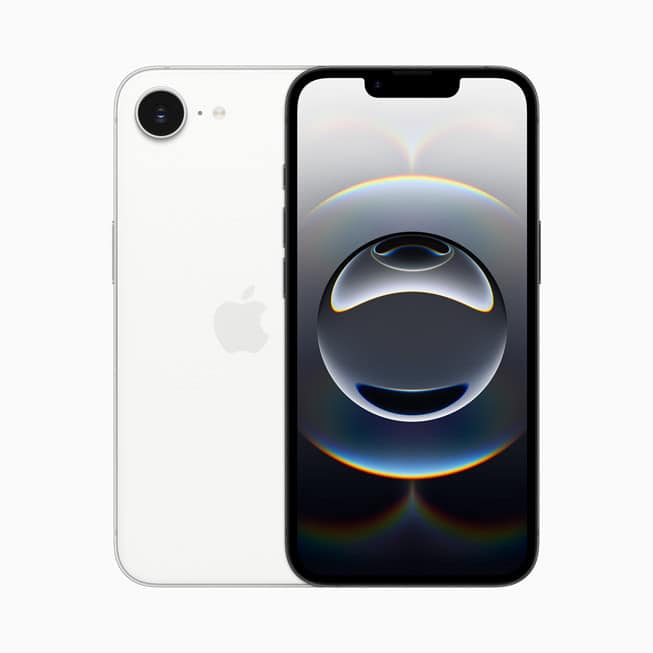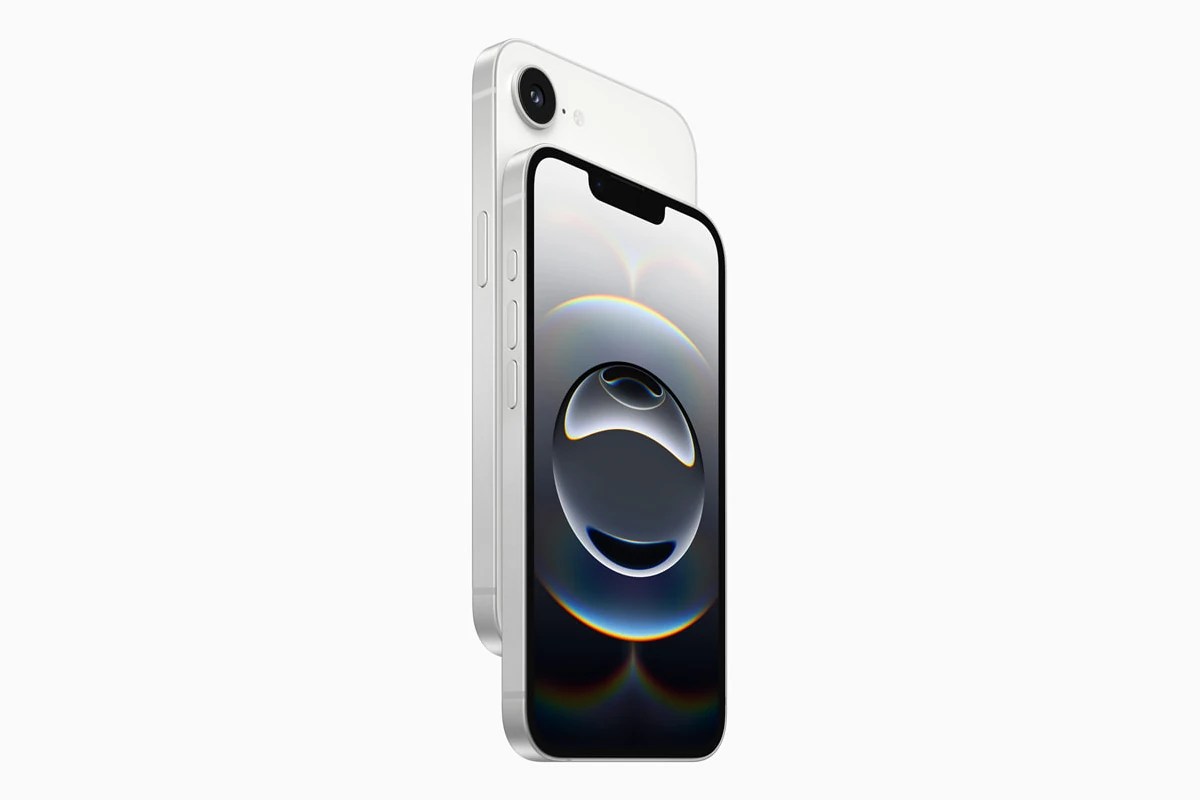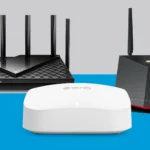Apple’s new “e” strategy is only a few months old, yet talk of an iPhone 17e is already heating up. After February’s successful launch of the iPhone 16e—an aggressively priced A-series device that slotted neatly between the SE and the mainstream line—supply-chain chatter suggests Cupertino will repeat the playbook with the next generation. The goal: keep upgrade momentum alive through winter and spring, rather than relying on a single September spike.
Where the 17e Fits in Apple’s Expanding Roadmap
- Timing: Multiple analysts now put the 17e in February–March 2026, roughly five months after the September 2025 debut of the core iPhone 17 line. That window gives Apple a fresh headline just as Samsung’s early-year Galaxy S26 FE and other mid-tier Android refreshes arrive.
- Purpose: Unlike the iPhone SE—which reuses older chassis designs—the “e” models are stripped-down versions of the current-year flagships built to hit a lower price but still look modern on store shelves.

Naming Turbulence: 17e vs. 17 Air
Early CAD leaks muddied the waters by tagging an “ultra-thin” handset as either iPhone 17 Air or iPhone 17e. Consensus now favors two separate skews:
- iPhone 17 Air – a razor-thin (~5–6 mm) 6.6″ device that ships with the September family, replacing the Plus.
- iPhone 17e – a physically smaller 6.1″ refresh that lands months later, targeting sub-$700 buyers who still want the latest industrial design.
Expected Hardware at a Glance
| Rumored Spec | iPhone 17e | Why It Matters |
|---|---|---|
| Chipset | A18 (binned) or A19 Lite | Keeps flagship-class performance without the Pro’s AI cores |
| Display | 6.1″ LTPO OLED, 120 Hz | Brings ProMotion to a lower tier, matching Android rivals |
| Memory | 8 GB RAM | Harmonizes with base iPhone 17 for easier cross-app QA |
| Camera | 48 MP dual rear, 12 MP front | Uses stacked-sensor tech from iPhone 16e for better low-light |
| Cooling | Graphite sheet (no vapor chamber) | Cost-effective thermal solution while Pro models go vapor chamber |
| Build | Aluminum frame, half-glass back | Trimmed materials cost vs. titanium on Pro |
| Battery | ~3,500 mAh, 30 W USB-C | Balances thinness with all-day runtime |
Price & Market Positioning
Internal discussions point to a $599–$699 US starting price—slotting just below the $799 standard iPhone 17. That undercuts Samsung’s Galaxy S26 base model and removes one of the last excuses for Android switchers who balk at Apple’s entry fees.
Why Apple Likes Mid-Cycle Phones
- Shorter upgrade cadence: U.S. carriers increasingly push 24-month financing; a February device arrives squarely when many 14-series contracts end.
- Global seasonality: Lunar New Year sales in China and Diwali planning in India both peak between February and October, not just fall.
- Regulatory wiggle room: The EU’s new durability directives kick in mid-2026; launching the 17e beforehand means Apple can reuse existing chassis tooling without retrofitting repair-friendly screws.
The Rest of the iPhone 17 Family (September 2025)
| Model | Key Hook | Launch Price (est.) |
|---|---|---|
| iPhone 17 | 6.3″ LTPO 120 Hz, A18, Dynamic Island 2.0 | $799 |
| iPhone 17 Air | Thinnest iPhone ever (~5–6 mm), single 48 MP cam | $899 |
| iPhone 17 Pro | A19 Pro (2 nm), 12 GB RAM, vapor-chamber cooling | $1,099 |
| iPhone 17 Pro Max | 6.9″ display, triple 48 MP + 24 MP front, 1 TB option | $1,299 |
Apple is betting that this five-device grid (including the 17e) will cover everything from emerging-market first-time buyers to mobile gamers chasing Pro-grade thermals. If the 16e’s brisk sales are any indicator, a spring-launch budget flagship could become a permanent fixture.
Key Takeaways
- Apple may release an iPhone 17e as part of its expanding product lineup strategy to reach more budget-conscious consumers.
- Supply chain leaks suggest the iPhone 17e and rumored iPhone 17 Air might be the same device with different marketing names.
- The release timing remains uncertain with predictions ranging from September 2025 alongside other iPhone 17 models to February 2026.
Evolution of the iPhone Series
Apple continues to refine and expand its iPhone lineup with each generation, adding new features while sometimes creating more specialized models to target different segments of the market. The upcoming iPhone 17 series represents another step in this ongoing evolution.
From iPhone 14 to iPhone 17e
The iPhone 14 marked a significant shift when Apple replaced the Mini variant with the Plus model, offering larger screens across the lineup. With iPhone 15, Apple standardized USB-C charging and expanded the Dynamic Island to all models.
The iPhone 16 series introduced the Action Button across all models and added the Camera Control button to Pro versions. Apple also launched the iPhone 16e as a more affordable option with some premium features.
Looking ahead to September 2025, the iPhone 17 family is expected to include an iPhone 17e model. This continues Apple’s strategy of providing more choices at different price points. The entire iPhone 17 lineup may feature ProMotion displays with higher refresh rates, previously reserved for Pro models.
Comparing iPhone 16 Series and iPhone 17e
The iPhone 16e serves as the entry point to Apple’s current lineup, offering solid performance in a more affordable package. The iPhone 17e is expected to build upon this foundation with several improvements.
Display and Performance:
- iPhone 16e: Standard 60Hz display
- iPhone 17e: Possible ProMotion 120Hz display
Camera System:
- iPhone 16e: Dual camera setup
- iPhone 17e: Expected dual cameras with improved 24MP selfie camera
Connectivity:
- iPhone 16e: Wi-Fi 6E
- iPhone 17e: Likely Wi-Fi 7 support
The iPhone 17e will likely maintain a balance between affordability and premium features. It may incorporate some technologies from the higher-end iPhone 16 Pro models while keeping costs lower than the standard iPhone 17.
Battery life improvements and enhanced processing power are also expected, following Apple’s typical year-over-year upgrade path.
Design and Display Innovations
The iPhone 17 series is expected to bring several key design changes and display improvements. Apple appears to be focusing on enhancing screen quality and durability while also reimagining how the camera system integrates with the overall design.
OLED Display Advancements
The iPhone 17 lineup will reportedly feature an improved OLED display with anti-reflective technology. This new screen is said to be more scratch-resistant than the current Ceramic Shield found on the iPhone 15 series.
The anti-reflective coating should help users see their screens more clearly in bright outdoor conditions. This addresses a common complaint about smartphone visibility in sunlight.
Display brightness may also see improvements, though specific nit measurements haven’t been leaked yet. The screen technology will likely maintain the deep blacks and vibrant colors OLED is known for while potentially improving energy efficiency.
Apple may also be working on thinner bezels for the iPhone 17, maximizing screen real estate without increasing the overall device dimensions.
Always-On Display Features
The Always-On Display functionality, previously limited to Pro models, might extend across the entire iPhone 17 lineup. This feature allows users to view important information without waking the full display.
Apple could enhance the Always-On Display with more customization options and better power management. Users might gain the ability to choose which widgets and notifications appear when the phone is in standby mode.
The Dynamic Island, introduced with iPhone 14 Pro, will likely continue evolving on the iPhone 17. It may gain new interactive capabilities and better integration with the Always-On Display to show live activities even when the phone is locked.
Battery optimization will be crucial for these features, as keeping any portion of the display active consumes power.
Camera Design Enhancements
The most noticeable design change for the iPhone 17 seems to be the camera system. Multiple leaks suggest Apple is moving away from the square camera bump toward an elongated horizontal camera module along the top of the device.
This “camera bar” design represents a significant shift from Apple’s recent aesthetic. The new layout may help solve Apple’s space limitations, allowing for larger sensors or additional camera components without increasing the phone’s thickness.
The iPhone 17 Pro Max specifically appears to embrace this horizontal design approach. This change could improve balance when the phone is placed on flat surfaces, reducing the “wobble” effect caused by current camera bumps.
The new camera arrangement might also provide better heat dissipation, potentially allowing for improved computational photography capabilities and extended recording times for high-resolution video.
Performance Upgrades
The iPhone 17e is expected to receive significant performance improvements over previous models. These enhancements focus on processing power and connectivity capabilities that will make the device more responsive and future-ready.
A19 Chip Power
The iPhone 17e will likely feature Apple’s A19 chip, which represents a substantial upgrade from current processors. Based on industry analysis, the A19 is expected to utilize a more advanced manufacturing process, possibly 3nm technology, resulting in better power efficiency and performance.
Experts predict the A19 chip will offer approximately 15-20% faster CPU performance and up to 25% improved graphics capabilities compared to its predecessor. RAM capacity may increase from 8GB to 12GB, as suggested by recent reports from supply chain analysts.
These improvements should translate to smoother multitasking, faster app launches, and better handling of resource-intensive applications. For everyday users, this means less waiting and more responsive interactions with the device.
5G Connectivity Enhancements
The iPhone 17e is rumored to incorporate significant advancements in 5G connectivity. Apple may equip the device with its custom C1 modem, replacing the Qualcomm components used in previous generations.
This transition to an in-house modem solution could provide several benefits:
- Improved power efficiency during network connections
- Better integration with other Apple hardware components
- Enhanced data speeds in various network environments
- More reliable connections in congested areas
The C1 modem is expected to support the latest 5G standards, including mmWave and sub-6GHz frequencies. If Apple continues its partnership with Qualcomm for the 17e, we might instead see their newest modem technology implemented.
These connectivity improvements will be particularly noticeable when streaming high-definition content, making video calls, or downloading large files on the go.
Pricing Strategy and Market Positioning
Apple’s pricing decisions for the iPhone 17e will likely shape its market position and appeal to different consumer segments. The company continues its tradition of strategic pricing to target specific demographics while maintaining brand value across its product lineup.
Comparative Price Tag Analysis
The iPhone 17e is expected to follow Apple’s mid-tier pricing strategy. Based on recent trends, the device might start around $599, similar to the iPhone 16e. This positions it as a more affordable alternative to the flagship models while offering better value than the budget iPhone SE line.
Apple typically maintains a $200-300 price gap between its entry-level and mid-range offerings. The iPhone 17e would sit comfortably between the SE (usually priced around $429) and the standard iPhone 17 (potentially priced at $899-999 according to rumors).
This pricing approach mirrors Apple’s earlier strategy with the iPhone 5c, which served as a colorful, more affordable option to the flagship models of its time.
Segment Targeting with iPhone 17e
The iPhone 17e appears designed to capture consumers who find premium models too expensive but desire more features than entry-level options provide. This strategic positioning aims to prevent customer migration to Android alternatives in the $500-700 range.
Apple is likely targeting several key demographics with the 17e:
- Budget-conscious upgraders from older iPhone models
- First-time iPhone buyers seeking Apple’s ecosystem without premium pricing
- Secondary phone users who want iPhone features without flagship costs
The device would compete directly with mid-range Android phones while offering Apple’s ecosystem advantages. This continues Apple’s pattern of product diversification seen with the iPhone SE and earlier with the 5c, allowing the company to reach price-sensitive segments without diluting its premium brand image.
Consumer Insights and Expectations
As the iPhone 17 lineup approaches, market research reveals interesting patterns in consumer behavior and anticipation for new features. Particularly, the rumored iPhone 17e has generated significant discussion about Apple’s strategy and consumer preferences.
Upgrade Trends Reported by CIRP
Consumer Intelligence Research Partners (CIRP) data shows shifting patterns in how users approach iPhone upgrades. Recent reports indicate many consumers are extending their upgrade cycles to 3-4 years, compared to the 2-year cycles common in earlier iPhone generations.
This longer retention period appears driven by several factors:
- Higher device costs making frequent upgrades less appealing
- Incremental improvements between generations seeming less substantial
- Better durability of current models
CIRP also noted that approximately 42% of iPhone buyers are specifically waiting for substantial new features before upgrading. The rumored iPhone 17e could potentially attract these hesitant upgraders if it offers unique value at a different price point than standard models.
SITI and Apple Intelligence Predictions
System Integration Technology Improvements (SITI) and Apple Intelligence features are expected to be major factors influencing consumer expectations for the iPhone 17 lineup. Industry analysts predict enhanced thermal management will improve performance of AI-powered features.
The iPhone 17e is rumored to incorporate core Apple Intelligence functionality while potentially making some compromises to achieve its price position. This balance of features versus affordability could significantly impact consumer reception.
Surveys suggest consumers prioritize these Apple Intelligence capabilities:
- Real-time translation (78% of respondents)
- Enhanced photo editing (65%)
- Contextual awareness features (61%)
Battery life implications remain a top concern, with 82% of potential buyers indicating they would hesitate to upgrade if Apple Intelligence features significantly impacted daily battery performance.
Technology Expert Opinions
Several industry analysts have shared their insights about the upcoming iPhone 17 series. These experts offer predictions about camera upgrades, cooling technology, and design changes that might appear in Apple’s 2025 lineup.
Predictions by Apple Analyst Jeff Pu
Jeff Pu, a respected Apple analyst, recently shared important details about the iPhone 17 in an investor note. He believes all iPhone 17 models will feature a significant selfie camera upgrade to 24 megapixels. This represents a substantial improvement from the current 12-megapixel front cameras.
Pu also mentioned that the iPhone 17 family will likely adopt vapor chamber cooling technology. This addition would help the devices maintain lower temperatures during intensive tasks like gaming or using AI features.
His report suggests Apple is focusing on enhancing the iPhone 17’s performance capabilities while also improving everyday features like selfie photography that matter to average users.
Fixed Focus Digital’s Forecast
Fixed Focus Digital analysts have published their own predictions about the iPhone 17 lineup. They suggest the standard iPhone 17 will have at least 8GB of RAM to properly support Apple Intelligence features.
Their report also highlights rumors about a slimmer “Air” design for one of the models. This aligns with Apple’s historical pattern of introducing thinner devices after establishing new technology standards.
The analysts point to possible changes in the Dynamic Island design, with the Pro Max variant potentially getting a smaller cutout. Some sources they cite reportedly refer to the top model as “iPhone 17 Ultra” instead of Pro Max, suggesting Apple might rename its premium offering.
Supply Chain and Manufacturing Updates
Recent reports suggest that iPhone 17e components have already been spotted in Apple’s supply chain, indicating early production preparations. These sightings align with rumors of Apple planning annual updates for their more budget-friendly models.
Production Volume Predictions
Industry analysts predict Apple will maintain aggressive production targets for the iPhone 17e, potentially surpassing initial iPhone 16e volumes. Supply chain sources indicate production could begin as early as Q4 2024 to meet a potential February 2025 release window.
The manufacturing strategy appears to position the iPhone 17e alongside the standard iPhone 17 lineup rather than as a replacement. This dual-track approach may help Apple capture different market segments throughout the year.
Factories in India may take on a larger role in iPhone 17e production as Apple continues to diversify its manufacturing footprint beyond China. This shift could help mitigate supply chain disruptions while potentially reducing production costs.
Material and Component Sourcing
Apple is reportedly securing components that suggest the iPhone 17e will share several features with the main iPhone 17 lineup. Supply chain observers note that display panels being sourced indicate the device may indeed adopt ProMotion technology across all models.
The company is also sourcing Wi-Fi 7 chips for implementation across the entire iPhone 17 family, including the 17e. This represents a significant upgrade over previous generation connectivity options.
Material procurement patterns suggest Apple may use similar chassis materials for both the iPhone 17e and the rumored iPhone 17 Slim. However, the premium iPhone 17 Pro Max will likely maintain exclusive use of titanium components to maintain product differentiation.
Component orders indicate larger display panels are being sourced, supporting rumors that the iPhone 17 lineup might feature increased screen sizes compared to the iPhone 16 Plus and other current models.
Model Differentiation and Features
Apple plans to introduce important changes across the iPhone 17 lineup in September 2025. The upcoming series will likely feature more distinct differences between models, with specialized features and design elements targeting different user needs.
iPhone 17 Pro and iPhone 17 Pro Max
The iPhone 17 Pro models are expected to receive significant upgrades that separate them from standard models. According to rumors, the Pro Max version might be rebranded as the “iPhone 17 Ultra,” marking a clearer distinction in the lineup.
The Pro Max (or Ultra) will likely feature three 48MP cameras, including wide, ultra-wide, and Tetraprism lenses. This represents a major photography upgrade, especially compared to current models.
Display technology is also improving, with ProMotion technology possibly extending across all iPhone 17 models. The Pro versions may feature a smaller Dynamic Island, giving users more screen space.
Other rumored Pro-exclusive features include:
- Enhanced vapor chamber cooling system
- Larger battery capacity
- Wi-Fi 7 connectivity
- Improved processing power
iPhone 17 Air as a New Contender
The iPhone 17 Air represents a potentially exciting addition to Apple’s lineup. As the name suggests, this model will emphasize thinness and lightness, creating a new category for users who prioritize portability.
The Air model may feature:
- Significantly slimmer profile
- Lighter weight construction
- Larger display size than standard models
Despite its thinner design, the iPhone 17 Air might still maintain competitive specifications. It could feature the same high refresh rate display technology as other models in the lineup.
The introduction of an Air variant would give Apple a four-model strategy, with each targeting different consumer priorities: standard for affordability, Air for portability, Pro for performance, and Pro Max/Ultra for ultimate features.
Frequently Asked Questions
iPhone enthusiasts are buzzing with questions about the potential iPhone 17e. Based on current leaks and industry patterns, here’s what we know about this rumored device.
What are the anticipated features of the upcoming iPhone 17 series?
The iPhone 17 series is expected to introduce several design upgrades across the lineup. Rumors suggest improved processing power with a new chip, likely the A19 or A19 Pro.
Enhanced display technology might include better brightness levels and possibly more efficient OLED panels. Battery improvements are anticipated, with longer life and potentially faster charging capabilities.
The regular iPhone 17 will likely maintain a similar design to the iPhone 16, with most significant changes happening in the Pro models and potentially the rumored iPhone 17 Air variant.
When can consumers expect the release of the iPhone 17e?
Based on Apple’s established release patterns, the iPhone 17 lineup will likely debut in September 2025. However, there are currently no specific rumors or confirmed reports suggesting an iPhone 17e model is in development.
If Apple does introduce an iPhone 17e, it would likely launch alongside the main iPhone 17 series or possibly as a mid-cycle refresh in early 2026, similar to how the SE models have been positioned.
How will the iPhone 17e differ from previous models?
While specific details about the iPhone 17e remain scarce, if it follows Apple’s naming conventions for “e” models like the iPhone XR and iPhone SE, it might be positioned as a more affordable option.
The device could potentially combine newer internal components with a slightly older design aesthetic. It might serve as an entry-level option while still offering some premium features.
Apple might use the “e” designation to introduce a new form factor or subcategory, possibly related to the rumored “Air” variant mentioned in some leaks.
What is the predicted price range for the new iPhone 17e?
Without official confirmation of the iPhone 17e’s existence, price predictions remain speculative. If positioned as a more affordable option in the lineup, it could be priced between $599-$799.
This would place it below the standard iPhone 17 and Pro models but above the budget SE line. The final price would ultimately depend on its feature set and positioning within Apple’s broader product strategy.
Are there any leaks concerning the iPhone 17e’s camera improvements?
No specific camera leaks for an iPhone 17e have emerged. If Apple follows previous patterns for entry or mid-tier models, the 17e might include a capable but slightly less advanced camera system than the Pro variants.
This could mean a dual-camera setup rather than triple, but with computational photography improvements. Apple typically prioritizes camera quality across all tiers, so even a potential 17e would likely offer solid photographic capabilities.
Will the iPhone 17e include any groundbreaking technology not seen in prior versions?
Current rumors don’t indicate any groundbreaking technology specific to an iPhone 17e model. Most innovative features typically debut in the Pro models before filtering down to other variants.
If Apple does release an iPhone 17e, it would likely adopt some technologies introduced in previous Pro models rather than introducing entirely new features. This approach would maintain Apple’s typical product differentiation strategy.
However, if the “e” designation marks a new direction or form factor, it could potentially introduce unique features tailored to a specific use case or market segment.







